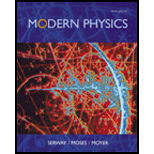
Concept explainers
(a)
The wavelengths of photons scattered at angles
(a)
Answer to Problem 26P
The wavelengths of photons scattered at angles
Explanation of Solution
Write the expression to calculate the change in wavelength.
Here,
Write the expression to calculate the wavelengths of scattered photons.
Here,
Substitute equation (I) in (II) to calculate the wavelength of scattered photons.
Conclusion:
Substitute
Substitute
Substitute
Substitute
Substitute
Substitute
Substitute
and
Therefore the wavelengths of photons scattered at angles
(b)
The energy of electrons at scattering angles
(b)
Answer to Problem 26P
The energy of electrons at scattering angles
Explanation of Solution
The energy of the electrons will be the energy lost from the photons.
Write the expression to find the energy of electrons.
Here,
Conclusion:
Substitute
Substitute
Substitute
Substitute
Substitute
Substitute
Substitute
Therefore, the energy of electrons at scattering angles
(c)
The scattering angle with which the electron gets the greatest energy.
(c)
Answer to Problem 26P
The scattering angle with which the electron gets the greatest energy is
Explanation of Solution
When the scattering angle is
After the head on collision the photon scattered straight back and the kinetic energy gained by the initially stationary electron will be the maximum. The kinetic energy gained by the electron at scattering angle
Want to see more full solutions like this?
Chapter 3 Solutions
Modern Physics
- What is the maximum kinetic energy of photoelectrons ejected from sodium by the incident radiation of wavelength 450 nm?arrow_forwardA photon of energy 5.0 keV collides with a stationary electron and is scattered at an angle of 60°. What is the energy acquired by the electron in the collision?arrow_forwardIs it possible in the Compton experiment to observe scattered X-rays that have a shorter wavelength than the incident X-ray radiation?arrow_forward
- In a beam of white light (wavelengths from 400 to 750 nm), what range of momentum can the photons have?arrow_forwardIf the work function of a metal is 3.2 eV, what is the maximum wavelength that a photon can have to eject a photoelectron from this metal surface?arrow_forwardIn the interpretation of the photoelectric effect, how is it known that an electron does not absorb more than one photon?arrow_forward
 Modern PhysicsPhysicsISBN:9781111794378Author:Raymond A. Serway, Clement J. Moses, Curt A. MoyerPublisher:Cengage Learning
Modern PhysicsPhysicsISBN:9781111794378Author:Raymond A. Serway, Clement J. Moses, Curt A. MoyerPublisher:Cengage Learning Physics for Scientists and Engineers with Modern ...PhysicsISBN:9781337553292Author:Raymond A. Serway, John W. JewettPublisher:Cengage Learning
Physics for Scientists and Engineers with Modern ...PhysicsISBN:9781337553292Author:Raymond A. Serway, John W. JewettPublisher:Cengage Learning Principles of Physics: A Calculus-Based TextPhysicsISBN:9781133104261Author:Raymond A. Serway, John W. JewettPublisher:Cengage Learning
Principles of Physics: A Calculus-Based TextPhysicsISBN:9781133104261Author:Raymond A. Serway, John W. JewettPublisher:Cengage Learning University Physics Volume 3PhysicsISBN:9781938168185Author:William Moebs, Jeff SannyPublisher:OpenStax
University Physics Volume 3PhysicsISBN:9781938168185Author:William Moebs, Jeff SannyPublisher:OpenStax



